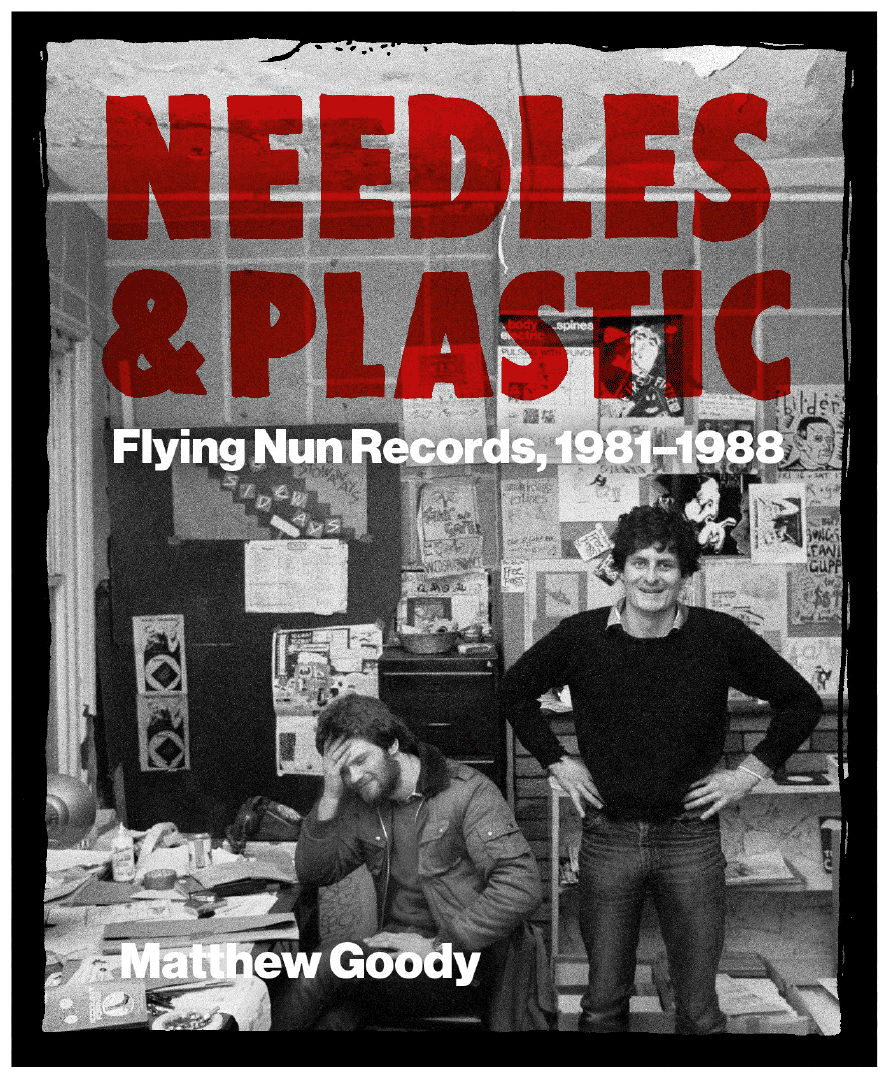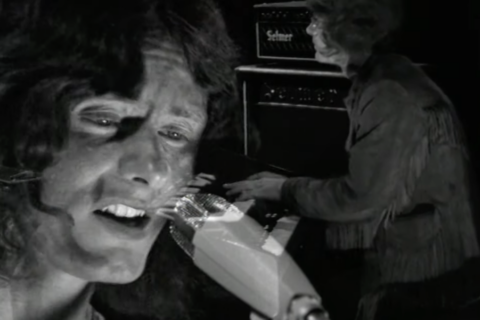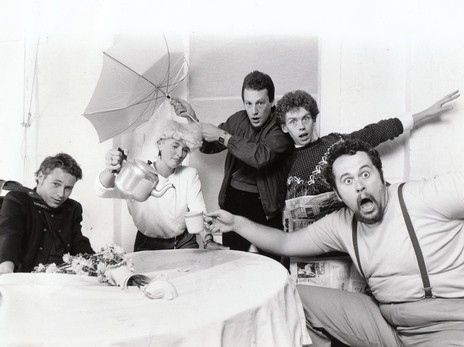Summary
Matthew Goody – Needles & Plastic (Auckland University Press), $69.99 BOOK REVIEW
Sometimes it takes an outsider to tell a story properly, writes GARY STEEL. Here’s the definitive tale of the first eight years of the Flying Nun label, then.
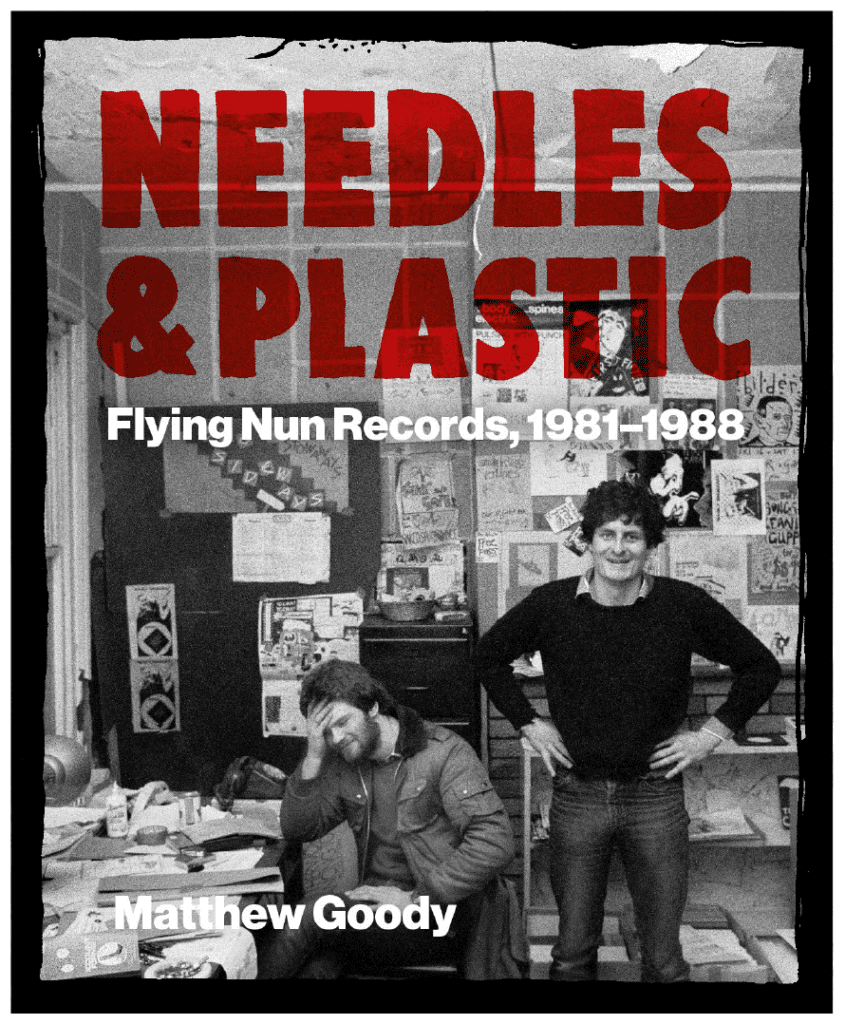 Heavy, man! No, not the content, but the actual book. This tome weighs a tonne! In fact, my shoulder blades are still aching from the sheer graft needed to manhandle its 418 pages, all the while training my beady, bloodshot, laser-like peepers at its lurid displays from various perches around the house.
Heavy, man! No, not the content, but the actual book. This tome weighs a tonne! In fact, my shoulder blades are still aching from the sheer graft needed to manhandle its 418 pages, all the while training my beady, bloodshot, laser-like peepers at its lurid displays from various perches around the house.
It feels deeply weird that such a lush, coffee-table account should have eventuated about a record label for whom the archaic Kiwi expression “held together with Number 8 wire” could have been invented. Famous for its ad-hoc, “garage” sound quality and sonic experimentation which took precedence over performative ability, Christchurch label Flying Nun pumped out an impressive catalogue of extraordinary, genre-busting releases during its peak years, and after some frankly fraught business nightmares in the ‘90s and early 2000s and an arid period, is back to being a going concern in 2022.
Support Witchdoctor’s ongoing mission to bring a wealth of historic NZ music interviews, features and reviews to you this NZ Music Month (and all year round) as well as coverage of quality brand new, contemporary NZ music. Witchdoctor, entertainment for grownups. Your one-off (or monthly) $5 or $10 donation will support Witchdoctor.co.nz. and help us keep producing quality content. It’s really easy to donate, just click the ‘Become a supporter’ button below.
But Needles & Plastic (a title taken from a tune Shayne Carter wrote for his early group Double Happys) is an account specifically of the first eight years of the label, when it was still based in Christchurch and stumbling from one handmade record cover to another, everything learnt on the hoof.
And it’s really, really good. Perhaps this most Kiwi of stories needed to be told by an outsider. Matthew Goody is a Canadian writer/researcher whose fandom of Flying Nun clearly knows no bounds, and he’s poured an inestimable effort into digging through the label’s ancient archaeology to produce the definitive account on every record, and every group associated with “the Nun” from its formation in 1981 to its last year in Christchurch, 1988.
Really an old-fashioned reference book that will thrill trainspotters and geeks, it’s probably better to digest in small doses. But personally, I found it a real page-turner, and the handsome design and copious photographs adorning every page added immensely to the information overload.
Goody writes in a measured fashion that suits the project. That he’s not prone to flights of fancy is a boon, in this case, because he needs his wits about him to tell a complicated story clearly. He does this by presenting every Flying Nun record chronologically and explaining the back story of the band and the record.
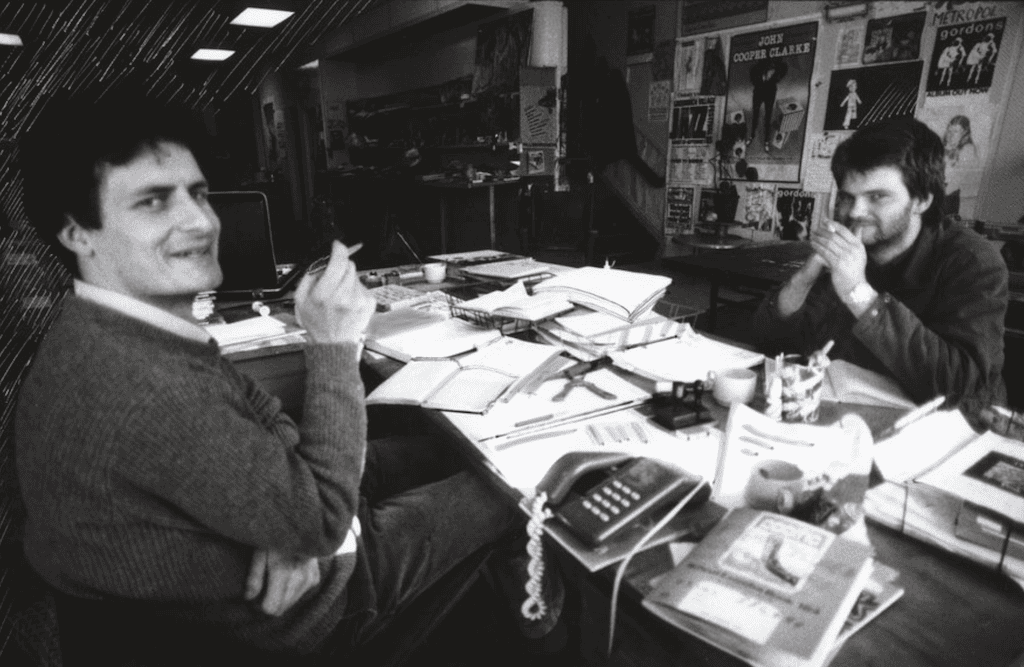
While the linking words and a certain amount of the critical assessments are his, Needles & Plastic is mostly a formidable work of research and the entries make extensive use of period quotes from those involved. Goody has clearly had to fact-find on occasions by talking to the musicians but he doesn’t conduct interviews himself. Some may question his extensive use of previously published interviews and reviews, but they ensure clarity, given the context.
What’s especially great about Needles & Plastic is the way the individual releases taken together more or less tell the story of Flying Nun, and make the reader feel something of the excitement owner Roger Shepherd and his (mostly voluntary) colleagues must have felt navigating what were completely new waters at the time.
Flying Nun, after all, had begun almost by accident and there was no handbook at the time on how to run a successful independent record company in New Zealand. A few other noble attempts – Ripper, Furtive, Propeller – had been made in the years immediately preceding Flying Nun’s advent, but they’d all found the going too tough for a variety of reasons (including a horrendous sales tax, geographical challenges for distribution, commercially-geared radio). Despite the almost instant success of Flying Nun with its cheap-ass recording of The Clean’s ‘Tally Ho’, Roger Shepherd soon discovered for himself just how cashflow hungry the project would be, even with so many devoting their time for free.
And then there are the individual stories. Some of them are necessarily less compelling than others, but the detailed approach to each release allows Goody to tease out what are often larger-than-life characters and some very odd tales indeed.
Many of these stories have been told to some degree by previous Nun-related books like Matthew Bannister’s Positively George Street, Roger Shepherd’s In Love With These Times and Ian Chapman’s The Dunedin Sound, but two of those are coloured by the experience of participating in the story, and the other is only about the Dunedin bands. Needles & Plastic is an essential document because for the first time it gives an array of musicians their just dues, and sometimes that means telling how hard done by some of the roster felt with decisions made by the hierarchy.
It’s also educative to see that – with the releases laid out chronologically – there’s a much more musically diverse catalogue than most would think. Sure, The Clean, The Chills, The Verlaines and Tall Dwarfs do somewhat dominate, but there are quite a few releases I’d never heard of… admittedly, mostly one-off singles that never made it to compilations. While the label’s 1980s output will forever be associated with pasty-faced lads in black jerseys playing Velvets-reminiscent jangle in damp Dunedin flats, there is some real diversity to be found. And even though the label never ventured into funk or reggae (imagine!) it did provide a launching pad for the two noisiest bands on the planet (The Gordons/Bailter Space), the creepy industrial soundscapes of Fetus Productions and The Skeptics, the wayward experimentation of both Marie & The Atom and From Scratch, and the hilarious headfuckery of The Axemen, to name a few. There were also several oddities, like the retro-rock and roll of Ritchie Venus & The Blue Beetles and The Eric Glandy Memorial Big Band.
The subject that comes up again and again in the book is the poor sound quality of some of the earlier recordings and the fuckups that were made, either with the masters, the pressings or the covers. Poor recordings were one of the reasons given by the then-ruling pop aristocracy in NZ as to why Flying Nun product wasn’t suitable for radio play, and it’s interesting to be reminded that at one stage the likes of Mike Chunn (formerly of Split Enz) and Neil Finn (who ironically, later became part-owner of Flying Nun) lashed out at the label and its artists for that very reason.
It’s not the job of Needles & Plastic to discuss the subject in detail, but clearly, there are multiple strands to the touchy subject of sound quality. The Tall Dwarfs, for instance, espoused a lo-fi aesthetic via their portable 4-track recorder that ran diametrically opposed to the slick recordings being pumped out by commercial record companies/bands. Some of the early Flying Nun recordings really were poor (especially those recorded at Nightshift in Christchurch) and failed to capture the artists at their best. The recordings captured by Chris Knox’s trusty 4-track, on the other hand, presented music in a certain way. What it lacked in sonic depth, some would maintain it made up for in coolness, a kind of garage aesthetic that had its own integrity. The various pressing errors associated with Flying Nun records in the last years of NZ pressing plants are a different story, and I’m sure they left a sour taste in many a musician’s mouth.
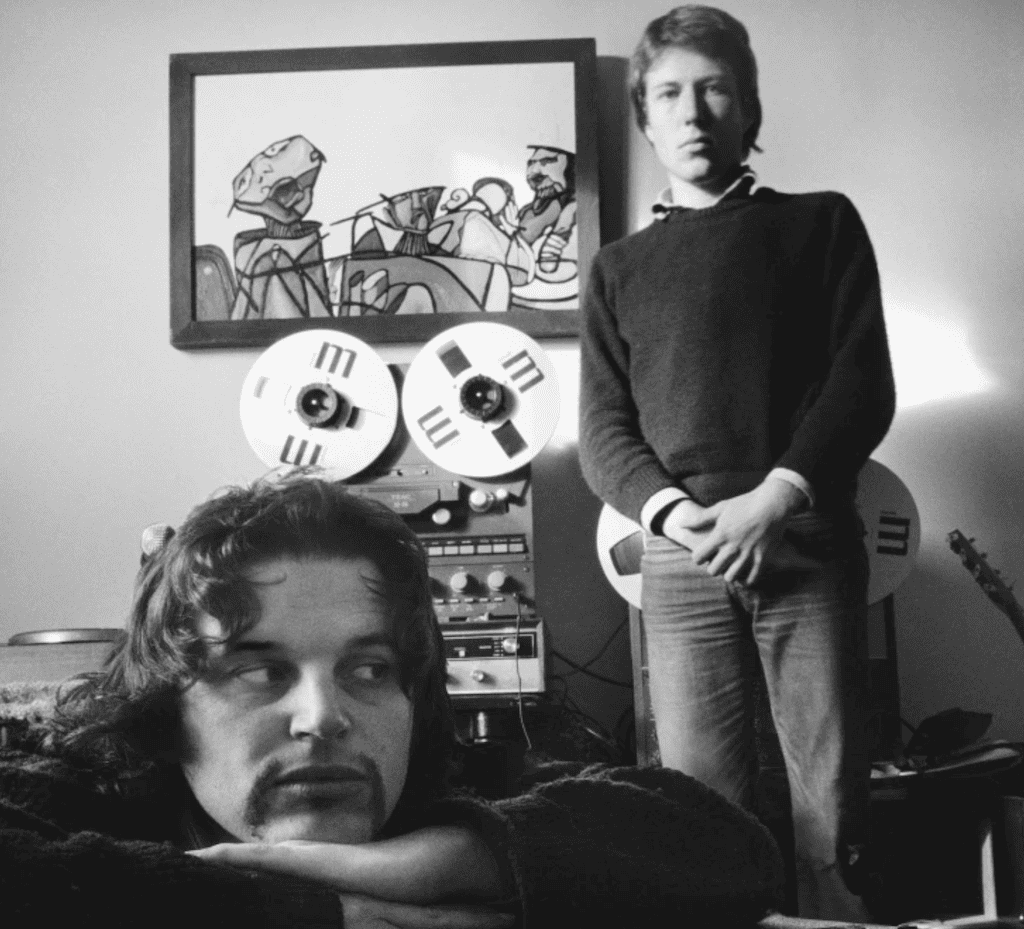
Are there any flaws in this great book? Well, I did get a bit fed up reading the same representatives of the music press quoted over and over again (Russell Brown, Colin Hogg…) and I wondered if Goody had missed out on various of the lesser-known pundits. However, a scan of the index shows quite a remarkable number of obscure sources, and it’s hardly Brown’s or Hogg’s fault that they were in the thick of it at the time.
The book takes two mild detours with a small section on Flying Nun setting up its UK office, and another about America’s increasing fascination with the label. While the crazy-about-Kiwi-music American Ron Kane is given a cursory acknowledgement (even if the late Long Beach resident we’re told was Hollywood-based) the early work he did in California to build an audience for NZ (including Flying Nun) records is omitted. I also noted a couple of minor errors relating to my own Wellington-based independent publications In Touch and TOM of the early-to-mid ‘80s, but that’s somewhat understandable given the obscurity of those music rags.
The biggest shock is when you come to the end and we’re only in 1988. Some of Flying Nun’s biggest successes were in the ‘90s and I felt aggrieved that there wasn’t a companion book to take me into the next decade and beyond. While it was great to read about Children’s Hour and the start of The Headless Chickens in Needles & Plastic, I wanted to read about their “breakthrough” commercial success in the ‘90s. While I enjoyed the fact that Peter Gutteridge had been a part of the first eight years of Flying Nun, I also really wanted to read about the great Snapper, which came just a bit late to be covered here.
I’m glad Goody called a halt to Needles & Plastic in ’88 though, because I could never have carried it from one room to the other. I hope that someone, sometime, completes the story. (I hope that some mad fool will someday also do a book about all the great independent music that wasn’t on Flying Nun in the ‘80s). In the meantime, this is a ripping read, and it’s got me keen to check out some of the titles that had somehow escaped my attention the first time round. What better recommendation is that?
Buy Needles & Plastic from my friends at NZ Bookshop of the Year 2021, Schrodinger’s Books.
Other Flying Nun-related content on Witchdoctor includes:
https://witchdoctor.co.nz/index.php/2012/09/pin-group-ambivalence-flying-nunwarner-cd-review/
https://witchdoctor.co.nz/index.php/2012/05/looking-up-the-flying-nuns-habit/
https://witchdoctor.co.nz/index.php/2017/05/new-zealand-music-month-chris-knox-the-lost-interview/
https://witchdoctor.co.nz/index.php/2016/05/every-day-in-may-day-31-the-clean/
https://witchdoctor.co.nz/index.php/2016/05/every-day-in-may-day-30-the-clean/
https://witchdoctor.co.nz/index.php/2019/05/shayne-carter-interview/
Read my review of Roger Shepherd’s In Love With These Times memoir here.

